The Battle of Bay Trail-D: GIGABYTE J1900N-D3V and ASUS J1900I-C Reviewed
by Ian Cutress on October 17, 2014 10:00 AM EST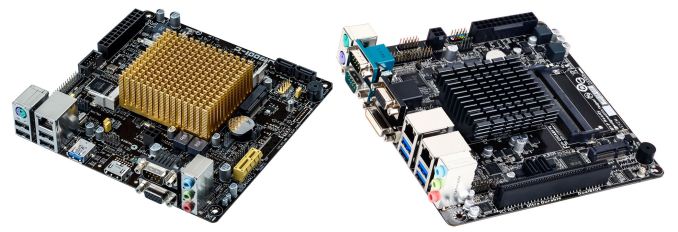
All the recent talk of Haswell-E and high-end refreshes has obscured the more casual computing market. The Bay Trail platform uses Intel’s Atom based Silvermont cores and competes directly against AMD’s Kabini for integrated computing, digital signage and cheap computing models. Today we compare two mini-ITX Celeron J1900 based motherboards: the GIGABYTE J1900N-D3V at $85 and the ASUS J1900I-C at $92, as well as the SoC itself.
Bay Trail-D Overview
Intel’s Atom Silvermont based architecture covers four SoC areas:
- Smartphones, in the form of Merrifield and Moorefield
- Tablets, Notebooks and Embedded in the form of Bay Trail
- Microservers and Storage in the form of Avoton
- Network and Communications in the form of Rangeley
We tested the C2750 eight-core Avoton SoC in the ASRock C2750D4I, a system oriented around maximum DRAM and storage in a mini-ITX form factor, and reported on GIGABYTE’s 46x C2750 Avoton server back at Computex 2014. The microserver market is apparently ripe for Avoton, but Bay Trail makes the desktop and tablet spaces a little more confusing.
Bay Trail comes in four forms:
- Bay Trail-D, for Desktop Systems at 6W to 20W
- Bay Trail-I, for Embedded and Automotive at 5W to 10W
- Bay Trail-M, for Mobile and Netbooks at 4W to 7.5W
- Bay Trail-T, for Tablets and Hybrids at 2W
We have covered Bay Trail in Mobile and Tablets, such as the ASUS Transformer Book T100 that has the Atom Z3740 Bay Trail-T, but the casual desktop space is still an interesting market. ECS’ LIVA is a perfect example of this: Ganesh’s review of the LIVA with the 4.5W Celeron N2806 Bay Trail-M shows that with enough innovation, some interesting designs can be produced.
Today’s review focuses on the Celeron J1900, a quad core 10W Bay Trail-D with Intel Ivy Bridge HD Graphics (6 EUs). The CPU has a base frequency of 2.0 GHz with a 2.42 GHz Turbo mode, 2 MB of L2 cache and support for dual channel DDR3L-1333. The J1900 was one of the targets of AMD’s AM1 Kabini launch earlier in the year, where the two traded blows on functionality:
| AMD Athlon 5350 vs. Intel Celeron J1900 | ||||
| Athlon 5350 | Celeron J1900 | |||
| CPU Architecture | Jaguar | Silvermont | ||
| CPU Cores | 4 | 4 | ||
| CPU Frequency | 2.05 GHz | 2.0 GHz / 2.4 GHz Turbo | ||
| GPU Cores | 128 SPs | 6 EUs | ||
| GPU Frequency | 600 MHz | 688 MHz | ||
| Memory Channels | Single | Dual | ||
| Memory Frequency | 1600 MHz | 1333 MHz | ||
| L2 Cache | 2 MB | 2 MB | ||
| TDP | 25 W | 10 W | ||
| Price | $59 | $82 | ||
AMD’s main power point for Kabini was the upgradable platform, due to Intel’s Bay Trail involving soldered on CPUs. Memory compatibility is traded, with Intel supporting dual channel but at a lower frequency. Price is also a battleground, along with GPU cores, although Intel uses significantly less power (on paper).
Because Bay Trail-D is a BGA processor, this means that the processor and motherboard must be purchased in tandem. There are a number of Bay Trail-D combinations available for purchase:
$200 – Jetway JNF9M-2930 (Celeron N2930, Bay Trail-M)
$150 – Habey MITX-6771 (Celeron J1900, Bay Trail-D)
$118 – ASRock Q1900TM-ITX (J1900)
$99 – ASRock Q1900DC-ITX (J1900)
$85 – GIGABYTE J1900N-D3V (J1900)
$80 – ASUS J1800I-A (Celeron J1800, Bay Trail-D)
$79 – ASUS J1800I-C (J1800)
$76 – ASRock Q1900-ITX (J1900)
$75 – Foxconn D190S (J1900)
$70 – ASRock Q1900M (J1900)
$70 – ASRock Q1900B-ITX (J1900)
$63 – Biostar J1800NP (J1800)
$60 – ASRock D1800M (J1800)
$60 – ASRock D1800B-ITX (J1800)
$60 – ASUS J1800I-C (J1800)
Thus for this review, we chose two of what might be the most popular Bay Trail-D motherboards for home builds: two mini-ITX systems, the GIGABYTE J1900N-D3V and the ASUS J1900I-C. Both of these use the Celeron J1900 processor, whereby the J1900 sits in the middle of Intel’s Bay Trail-D offerings but is the top SKU with the Celeron nomenclature:
| Bay Trail-D Comparison | |||||||
| Cores | CPU Frequency |
TDP | L2 Cache | IGP | IGP Frequency |
Price | |
| Celeron J1750 | 2 | 2410 | 10W | 1 MB | HD (Ivy) | 688 / 750 | |
| Celeron J1800 | 2 | 2410 / 2580 | 10W | 1 MB | HD (Ivy) | 688 / 792 | $72 |
| Celeron J1850 | 4 | 2000 | 10W | 2 MB | HD (Ivy) | 688 / 792 | |
| Celeron J1900 | 4 | 2000 / 2420 | 10W | 2 MB | HD (Ivy) | 688 / 854 | $82 |
| Pentium J2850 | 4 | 2410 | 10W | 2 MB | HD (Ivy) | 688 / 792 | |
| Pentium J2900 | 4 | 2410 / 2670 | 10W | 2 MB | HD (Ivy) | 688 / 896 | $94 |
| C2550 (Avoton) | 4 | 2400 / 2600 | 14W | 2 MB | None | N/A | $86 |
| C2750 (Avoton) | 8 | 2400 / 2600 | 20W | 4 MB | None | N/A | $171 |
Four Silvermont cores at 2 GHz for 10W sounds impressive, especially when I think back a decade to what I had back at university, or the 35W Core 2 Mobile CPU I had in my last laptop. As we found with the C2750, single thread speed should be reasonable and while multithreaded applications can take advantage, it doesn’t replace an i3, but ultimately that is not the intended market. Both the GIGABYTE J1900N-D3V and ASUS J1900I-C are going for that base desktop market, where ‘some memory’ and ‘some storage’ are needed, such as digital signage, a basic HTPC or run-of-the-mill all-access government machines.
It is worth noting that for Bay-Trail D, there are two steppings of the processors:
The new C0 stepping allows Intel Quick Sync to be used, but aside from the change in stepping (B3 to C0) there is no other outward indication which version is going to be used unless you are a customer that deals with Intel directly. Even though our samples in this review were new, both contained the B3 stepping version of the SoC.
Nevertheless, some of the Bay Trail-D SKUs to come with a form of Intel Burst, allowing parts of the SoC to turbo depending on how power is needed:
The Bay Trail Chipset
Similar with AM1, the integration of the IO into the SoC means there is no formal south bridge to distribute the ports and all routing is via the SoC:
Here the System Agent negotiates data between the dual channel DDR3L memory controllers, the Silvermont dual core ‘modules’ and the graphics, supplied as 6 EUs based on the Ivy Bridge video architecture. Because the Bay Trail SoC supports far fewer I/O connections compared to our usual foray into consumer based motherboard/CPU combinations, a mini-ITX is enough to almost fit them all.
The full block diagram for the J1900N-D3V is:
The SoC allows four PCIe 2.0 lanes from the chipset, which the manufacturer can use network connections or other IO controllers for. Here GIGABYTE has used two for Realtek NICs, one for a PCIe to PCI bridge and a mini-PCIe for a WiFi card or similar. The SoC supports two SATA 3 Gbps and a single USB 3.0 port, with this GIGABYTE motherbaord using a Renesas hub on that USB 3.0 to expand the offering to four.
Here is where Bay Trail comes across an issue. The system is designed to be cheap and competing with Kabini, meaning that motherboard manufacturers cannot fill the product up with controllers that cost a lot. It would be interesting if the PCIe lanes were used for additional SATA controllers, allowing for a large storage system, but that ends up being exactly what the C2750D4I is. Also, the decision here on the GIGABYTE to use a PCI slot will be for legacy use, as the latest graphics card available that uses PCI would be a HD 5450 or GT610/430.
Legacy connectors are always a touchy subject. Some motherboard reviews on products with a PS/2 or PCI slot might end up with a comment wondering why they still exist. The answer lies in industry, because upgrading that $1,000 PC is cheaper than upgrading the $5,000,000 bit of 15-year old equipment it is connected to. Bay Trail-D, even though is offered to the public, has a use in these motherboards for industry, so GIGABYTE and ASUS have to cover the bases. There are a few key points to consider in this respect:
- Does it have the right connectors?
- Does it cost a lot?
- Is it easy to set up?
- Is it responsive enough?
- Will it compute as much as is needed in a reasonable time?
The last two points end up being the usual reason for upgrading. For example, back in the lab I worked in several years ago our vintage equipment (an older version of this) ran on Pentium 4 machines but required a legacy slot for the proprietary communication and control card it ran on. In order to upgrade, it had to meet the above criteria. This is why legacy still exists.
Back to the review: we are putting both the GIGABYTE J1900N-D3V and the ASUS J1900I-C through their paces for usability as well as the J1900 SoC for responsiveness. These boards are in the $85-$95 mark, providing a competitive price point against AMD’s Kabini. Motherboards at the cheaper end of the spectrum tend to be worked on by less people, purely because the profit margins are low. Both the motherboards in this review are dealing with the fact that they have to include the SoC on the motherboard at the point of sale. Intel lists the price of the J1900 as $82, meaning that these SoCs are actually sold at a discount or in a discounted-revenue strategy, or the motherboard manufacturers are getting them severely discounted in order to make cents per sale.


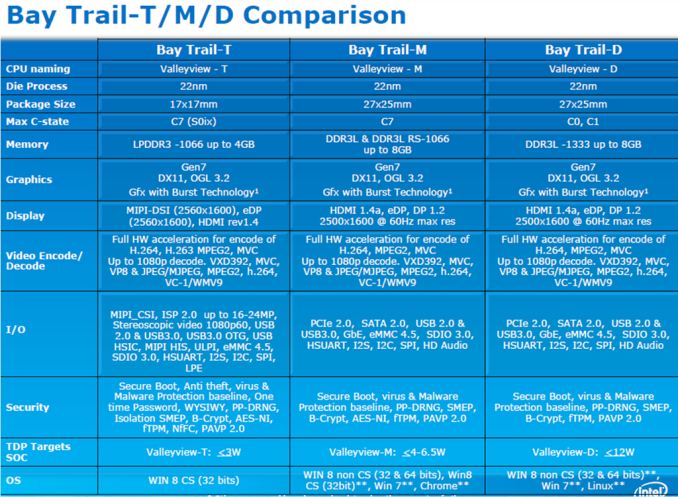
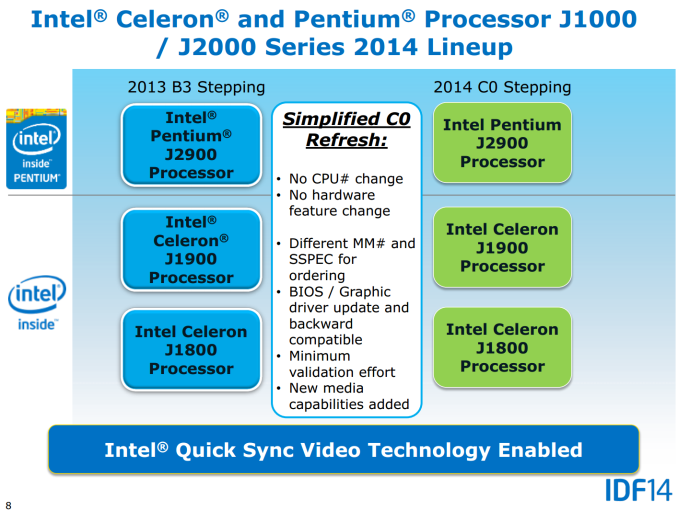
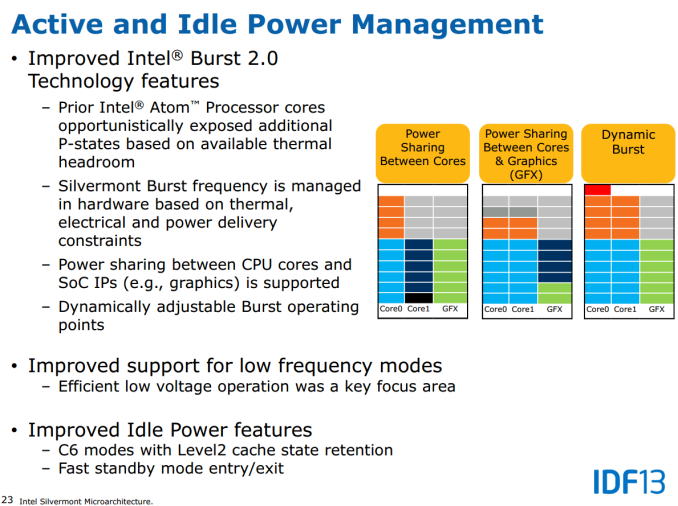
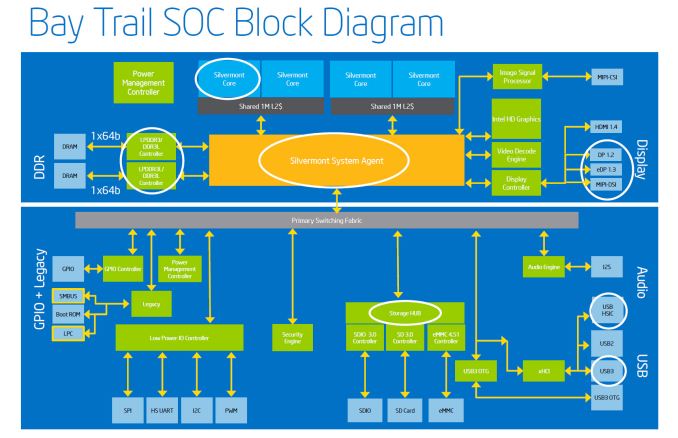
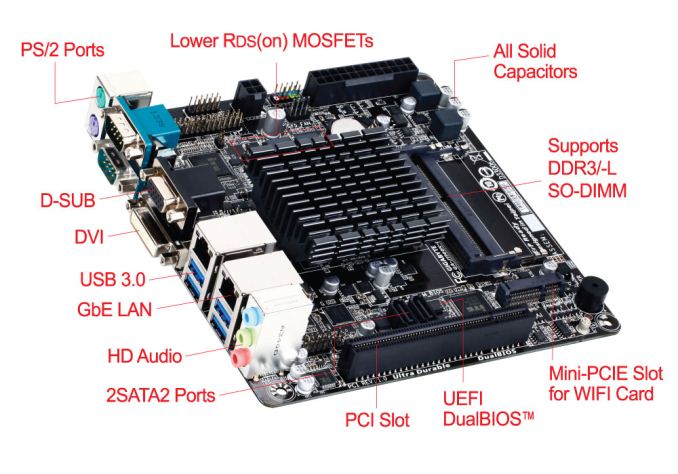
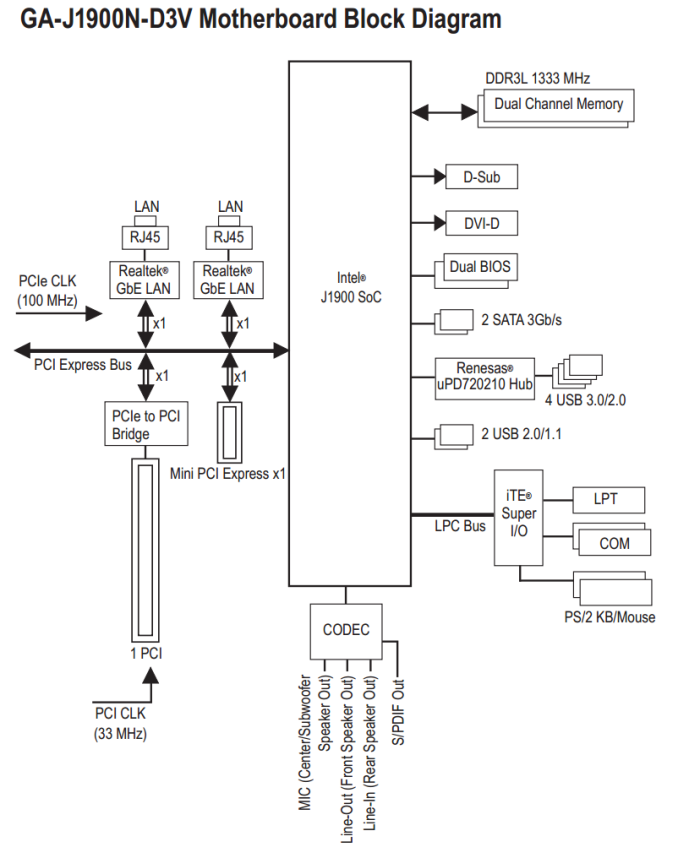








60 Comments
View All Comments
Factory Factory - Friday, October 17, 2014 - link
I recently bought the ASRock J1900-ITX for a cheap NAS/HTPC/Steam Home Streaming build, and I have to say I'm really pleased with it. It seemed like a great midpoint between the Gigabyte and Asus boards here: visual BIOS with fan controls, two USB 3.0 ports in back plus a header, DVI and HDMI both, ALC892 with optical audio out, and - this was big for the NAS part - two extra ASMedia SATA ports and a PCIe x1 slot. I stuck another ASMedia-based SATA card in the PCIe slot and shoved the whole thing in a Bitfenix Prodigy with a bunch of drives.I almost went with an AM1 build, but I knew that all my media and SHS worked fine with my Bay Trail tablet, and an Athlon 5350 and ASRock AM1H-ITX just didn't seem compelling at $50 more for the set (or even $25 more for an AM1B-ITX) and extra power consumption.
jospoortvliet - Saturday, October 18, 2014 - link
Note that unless you load you system all the time, the AM1 might actually have saved you power - idle is lower in most tests than Intel.abufrejoval - Tuesday, October 21, 2014 - link
Could you please add AM1 idle power figures?I've measured 10Watt idle power behind the Pico-PSU power supply for the GIGABYTE J1900N-D3V and 6.3 Watt idle power on the GIGABYTE GA-J1800N-D2H which is the dual core edition without the 2nd GBit port, the Renesas USB 3 hub, serial ports etc.
Top power consumption in mixed Prime95, Furmark loads including some USB peripherals was 28 Watts for the Quad and 22 Watts for the Dual.
A Cruical C300 SSD was used in all cases, which doesn't yet support the nice power saving features of the newer Crucial SSDs.
I've tried shutting down unused peripheral devices (e.g. serial ports, 2nd Gbit Ethernet) and limiting the PCIe speed to gen1 to see whether that had any measurable impact: It didn't for idle.
I've been an AMD fan for decades, but I'm also trying to stay objective.
And with regards to idle power and AMD:
While I've measured surprisingly good idle power values for my first Trinity based APU (A10-5800K) as low as 18Watts with a high-end Asus motherboard, I'm shocked that my Kavery variant (A10-7850K) won't go below 30Watts all measured at behind the PSU.
At the same time I've measured Gigabyte Brix using Intel A7-4500U CPUs (GIGABYTE BRIX GB-BXi7H-4500U) which achieved 7.5 Watts of idle power, but beat the A10-5800K on pretty much every benchmark, CPU, GPU or both while it didn't exceed 25 Watts of system consumption (vs. 100 Watts for the AMD APU).
Again I'd love to be able to report otherwise, but compute power per Watt is AMD's high-end weakness and idle power the low-end weakness. Which one is more important depends on your use case but both are currently killer criteria.
abufrejoval - Tuesday, October 21, 2014 - link
The coolest thing about the ASrock boards is that they support 16GB of DRAM!Officially BayTrail tops out at 8GB but this may turn out to be more of a typical Intel "product castration" feature than a hardware limit. I haven't actually tried this on my GIGABYTE J1900N-D3V and would be afraid, that the BIOS might still limit that board to 8GB, but I've seen reports of people using ASRock Q1900B-ITX or ASRock Q1900M (includes a physical PCIe x16 slot with x1 connectivity) with 16GB of DRAM.
mjnhstyle100x - Friday, October 17, 2014 - link
The power consumption delta is something I do not like. I rather see the idle and load instead. The idle tells me how much my "nas/htpc" system will consume while doing nothing. the load tells me what is the absolute worse it will consume. this allows me to weigh the options better on power consumption basis, not the delta as that's not what is going to matter when the system is going to be idling for prolonged periods.The power consumption delta is something I do not like. I rather see the idle and load instead. The idle tells me how much my "nas/htpc" system will consume while doing nothing. the load tells me what is the absolute worse it will consume. this allows me to weigh the options better on power consumption basis, not the delta as that's not what is going to matter when the system is going to be idling for prolonged periods.
anactoraaron - Friday, October 17, 2014 - link
I decided to flip back and forth to compare the 3770 and 3740 Bay Trail T to the Bay Trail D... It's surprising how well the lower powered T fares when compared to the D.rootheday3 - Friday, October 17, 2014 - link
Table on page 1 says Baytrail graphics has 6 EUs => not correct; Baytrail only has 4EUs.duploxxx - Friday, October 17, 2014 - link
poor poor Bay-trail GPU, only half the performance of the competing AMD part. No wonder Intel lost money in that segment. You would expect that in 2014 Intel would understand that graphical is actually what you see and use these days. Even CPU it is not faster. This is again a moment like the brazos part, this was also way better then the atom, yet the djingle and oem designs forced everybody to buy that peace of crap because there were only few brazos designs.pitty that we dont see amd mullin tablets for x86, no those OEM yet have to get money to be convinced from intel because they know they get poor cpu designs............... and then complain the market does not accept these tablets, i have a crapy atom tablet here which now is just a radio station, no added value at all for anything else
consumers are losing as usual.
silverblue - Friday, October 17, 2014 - link
Apparently, the A6-6310 has a 15W TDP and a much faster GPU, using just over half the power of the 5350. Its base clock is 250MHz lower at 1.8GHz, but has a 2.4GHz turbo. The A5 is also enabled this time around.I'd really like to see one of these go through some thorough tests on AT; could make for a very interesting little machine. It's just a shame that they have gone for faster RAM over a dual channel controller, but the controller itself uses less power than before which is helpful.
abufrejoval - Tuesday, October 21, 2014 - link
Running PC games on the box isn't a lot of fun fore sure, but running Android x86 gave quite another picture: The GPU may not be able to hold water against PC GPUs but it's quite powerfull enough for any Android game and benchmark that I tried, at least at 1080p.Tons more CPU power than the Snapdragon 800 on my Galaxy Note 3 and GPU performance in the same region.
Sure the Snapdragon would never dream of burning 10Watts of power for that performance, but the GIGABYTE GA-J1900N-D3V isn't meant to be carried in your pocket. As high-end HDMI stick alternative, it doesn't do too badly.
Nor as a Windows or Linux desktop for office work.
With Lollipop we might see these use cases merge and full desktop office suites like Softmaker's will do the transition.